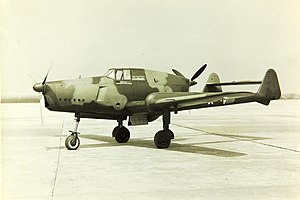There's an obscure alt-hist novel devoted to WWII era airship-wanking titled
ZRS by Rowan Partridge. There are quite a few issues with it, but the relevant thing here is the squadron of fighter-scouts attached to the
USS Long Island, the second-generation stretched Naval rigid cruiser the story is centered on. These fighters are hook-on, that is they recover to the airship by flying under it where hooks on the planes' spines snag trapezes hanging from the airship, then they are hauled up. So the author figured the
Bell XP-77 would fit the bill.
Note by the way that the basic ZRS concept as developed by Captain Wiley (I believe his rank was Commander but he captained the real-world airship) of the
USS Macon addresses the recently current issue here of the naval strike force; the original concept of naval rigid airships as promoted by the eventual Admiral Rosendahl was for them to serve as "eyes of the fleet;" flying many hundreds of feet up they would survey many thousands of square miles at a glance; cruising at speeds twice that any surface ship could manage they could scout out huge swathes of ocean, identifying which areas of the sea the enemy fleets or detached units were
not in (which already helps by allowing fleet commanders to concentrate on the not-yet surveyed sectors) and then eventually finding the enemy.
(At that point, the airship skeptics pointed out, the airship might be as good as lost, since the enemy would no doubt attack the rigid if they had any kind of naval aviation at all, and it seemed a foregone conclusion, to skeptics anyway, that the airship would be brought down without too much difficulty by any sort of airplane. On at least one occasion Rosendahl replied the airship would by then have served its purpose

and at a lower cost than trying to do the same with surface cruisers.)
The plans for the 1930s rigids included provision for a small squadron of small airplanes of various types, to hook on; some would be utility "shuttlecraft," others would be warplanes. The idea was to protect the airship with fighter cover, but when Cmdr Wiley got ahold of the
Macon, the last OTL rigid built in the USA, he conceived his small squadron of tiny biplane fighters as "eyes of the eye;" they'd fly a scissors formation ahead of the airship, sweeping out a still vaster range of water ahead, and the odds would be good the enemy would not see the little planes before their fleet elements were spotted; the airship would at that point still be over the horizon and with a good head start on any enemy retaliation; it could run for it.
Or attack--here's where the torpedo bombers or other attack planes come in--having located the targets, the range and endurance of the strike craft need not be tremendous; speed and warload would be the criteria.
So there's your solution to the long range, uncertain location naval strike dilemma; using scout airships that host light scout planes, sweep out the sea, and send in the killer planes with their direction. Or possibly base them on the same airship if the latter is big enough...
There are a lot of issues with Partridge's notions of just how this concept would play out, but I rather liked his choice of aircraft like the Bell ones--very small, but highly maneuverable. The OTL XP-77 rather sucked, but the author's suggestion that an airship-specialized version could take a better, hotter engine because it would not need to use high power at low airspeeds to take off and climb seems reasonable to me; with more power the thing might have been wicked in combat.
But--"P-77"? In the
Navy? The torpedo strike planes aboard LI were properly Naval designated; a letter for their function, a letter-number combination for their manufacturer and sequence of planes of this type that contractor had had accepted for this role by the Navy, and at the end a "Z" to indicate that this model was adapted for airship service--that is, it was lightened, had its landing gear deleted and replaced by a hook.
Partridge very unaccountably kept the insane Army type designation for the fighters though; insane because for one thing the high number indicates that the real-world light fighter was a mid-war desperation fall-back plan, to make large numbers of cheap fighters from non-strategic materials--whereas the author needs these ATL Bell planes fully accepted and operational before Pearl Harbor. The Army designation would in this ATL be a far lower number, somewhere in the 30s, and that would play merry hell with every other famous Army Air Corps/Forces fighter type's designation too. But the Army in this timeline has nothing to do with it; this is a Navy plane with a Navy purpose.
So most insane of all because there is simply no way the Navy is going to operate anything under an Army designation!
Here we have a fighter, which the Navy identified with a simple "F," no coyness about "pursuit" for the seadogs! The manufacturer is Bell, who OTL sold an experimental version of their Aircobra for carrier service (it was not adopted however) first to the USN, thus the "Airabonita" was designated XFL--no number after the L for "Bell" because it was the first accepted. However, in this ATL clearly the lightweight aircooled airship scout/defender design must have been offered and accepted some years before the war, beating out the Cobra alternate which if accepted would then be F2L.
For airship service of course the designation requires a specialty letter on the end, in this case Z.
FLZ.
Clearly known to its flyers and fans as the "Floozy."

Its detractors may want to call them "Fleaz."

If Partridge were a better author he could hardly have missed this opportunity.






